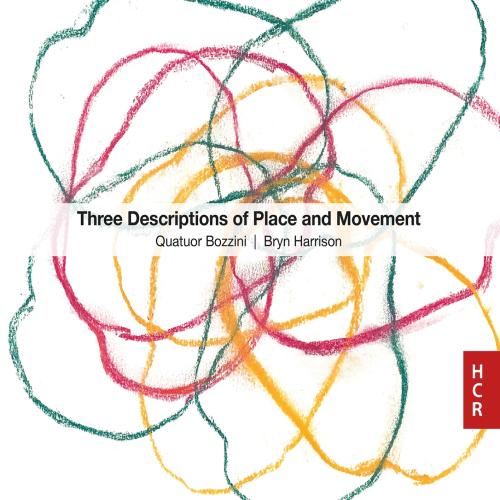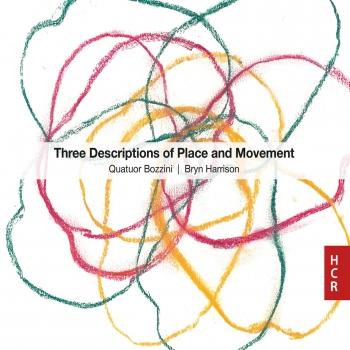
Bryn Harrison: Three Descriptions of Place and Movement Quatuor Bozzini
Album info
Album-Release:
2022
HRA-Release:
20.07.2022
Label: Huddersfield Contemporary Records
Genre: Classical
Subgenre: Chamber Music
Artist: Quatuor Bozzini
Composer: Bryn Harrison (1969)
Album including Album cover Booklet (PDF)
- Bryn Harrison (b. 1969): Three Descriptions of Place and Movement:
- 1 Harrison: Three Descriptions of Place and Movement: No. 1, Opening 05:04
- 2 Harrison: Three Descriptions of Place and Movement: No. 2, Clearing 23:11
- 3 Harrison: Three Descriptions of Place and Movement: No. 3, Burrow 33:35
Info for Bryn Harrison: Three Descriptions of Place and Movement
Following the success of their 2017–18 collaboration (Bozzini+, Piano Quintet, HCR19), the Bozzini Quartet is reunited with composer Bryn Harrison for Harrison’s first string quartet, the three-movement, hourlong Three Descriptions of Place and Movement (2021). A first string quartet is a landmark moment for any composer, but Harrison’s feels like a particularly significant arrival: the homogenous instrumentation is ideally suited to the disorienting labyrinthine structures, intricate repetitions, and extended durations that have characterised much of his recent work.
The title’s three ‘descriptions’ are clarified in the names of the movements. Opening, clearing, and burrow—all doubly verbs and nouns—are each embedded with simultaneous motion and stasis. Opening, an unfolding, widening, growing from a single point, as well as the aperture, the crevice, the window that frames the perception of space. Clearing, a kind of purging or scrubbing of materials down to their barren core, or a wide empty space, flat and nondescript, defined by the negative. And burrow, to carve deeper, to dig into, to bury oneself completely, or an underground cocoon, warm, enveloping, home.
Opening is constructed from a complex layering of information that obscures a rather simple harmonic motion: twin chromatic scales, one ascending, one descending, chasing each other in a wrapped double helix that opens, closes, and opens again. Tracing any one pattern, however, is instantly obfuscated by the displacement of successive pitches across octave and player, and by rhythmic patterns that control the speed at which each scale progresses.
After such intense concision and density, Clearing feels dangerously still. The same cross-hatched pitches, once buried by layers of complexity, are now laid bare at a permeating pianissimo. For nearly 25 minutes, the quartet enters in perfect rhythmic unison—two players at a time, six times a bar, at 63 beats per minute—unfolding the same spiral of pitches as before. Once the ear has grown accustomed to traceable consistency, Harrison introduces the first repeats in the work, catching the music mid phrase, insisting it revisit and review its pathways over and over again.
Burrow, the quartet’s final and longest movement, features the live quartet playing against two pre recorded versions of itself in canon, repeating the pitches and rhythms from opening verbatim but slowed now to half the original speed. Extensive repetitions, absent in opening, lodge the music further, and what was once a fleeting object becomes a fixated, rotating monolith stretching out in all directions.
"This is not music for the fainthearted, but for anyone with an interest in new music for string quartet, and in music that pushes the boundaries not just for performers but listeners too, this is an unusually captivating disc. Brilliantly recorded by James Clemens-Seely at Montreal’s Église St-Joseph de Rivière-des-Prairies in an acoustic that allows just the right amount of acoustic space around this experiment in time, and superbly performed by the Quatuor Bozzini, it’s a thoroughly recommendable album." (Europadisc)
Quatuor Bozzini
Das Quatuor Bozzini
1999 gegründet, ist eine der originellsten Stimmen in der neuen, experimentellen und klassischen Musik. Vor allem zeitgenössisch ausgerichtet ist es entscheidender Impulsgeber in der hyper-kreativen Szene Montréals und darüber hinaus. Das Quartett gibt sich nicht mit dem bereits Erreichten zufrieden, sondern bewegt sich risikofreudig außerhalb der ausgetretenen Pfade. Auf der Basis strenger Qualitätskriterien haben sich die Mitglieder des Quartetts ein breites und vielfältiges Repertoire aufgebaut, das sich nicht nach aktuellen Moden richtet. An die zweihundert Auftragsarbeiten sowie über dreihundert Erstaufführungen sind seit seiner Gründung entstanden. Ein Konzert mit dem Quatuor Bozzini ist immer ein intensives, auf alle Sinne ausgerichtetes und mit Liebe zum Detail gestaltetes Erlebnis.
Quatuor Bozzini wurde im Bandcamp Daily für seine „außerordentliche Musikalität und Sensibilität“ (Musicworks, Kanada) und als „eines der mutigsten Streichquartette der Welt“ ausgezeichnet. Jährlich veranstaltet es eine Konzertreihe in Montréal und darüber hinaus unternimmt es Tourneen in Kanada, den USA, Südamerika und Europa. Und es ist auf international renommierten Festivals und Veranstaltungsorten präsent, so unter anderem bei MaerzMusik (Berlin), Ultima (Oslo), Huddersfield (Großbritannien), Klangspuren (Österreich), Tsuda Hall (Tokio), Musiekgebouw (Amsterdam), November Music (Niederlande), Présences (Frankreich), Kortrijk (Belgien), TimeSpans (NYC), Porgy & Bess (Wien) und Other Minds (San Francisco). Um ihre Kunst kontinuierlich weiterzuentwickeln, haben sie verschiedenen Formate entwickelt wie das Musiklabor, die Composer’s Kitchen, die Performer’s-Kitchen und das Bozzini-Lab. Ziel dabei ist, die kommende Generationen von Komponist*innen und Interpret*innen zu fördern und zu unterstützen. Das Quartett betreibt sein eigenes Plattenlabel Collection QB und hat von der Kritik hochgelobte Alben herausgegeben, von denen viele zu Referenzaufnahmen darstellen. Weitere CDs wurden bei Edition Wandelweiser, Another Timbre, Wergo-Deutscher Musikrat, Centrediscs und ATMA Classique veröffentlicht.
Im Jahr 2018 wurde Quatuor Bozzini vom Conseil québécois de la musique mit dem Prix Opus – Performer of the Year ausgezeichnet. Quatuor Bozzini, Finalist des 28. Grand Prix (Conseil des arts de Montréal, 2012), erhielt außerdem drei weitere Opuspreise: „International Outreach“ (2007), „Contemporary Disc of the Year“ (2004) und „Discovery of the Year“ (2001) sowie den Étoile-Galaxie-Preis von Radio-Canada (2001), den Förderpreis der Ernst von Siemens Musikstiftung (2007), den Preis der deutschen Schallplattenkritik für Arbor vitae (2009) und den Friends of Canadian Music Award 2014.
Booklet for Bryn Harrison: Three Descriptions of Place and Movement











